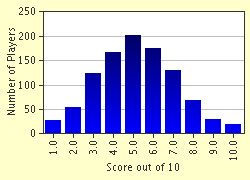Quiz Answer Key and Fun Facts
1. The International System of Units, or SI units, (which is actually short for "Système International d'Unités") is a very widely accepted system for units of physical quantities. What is the SI unit of the physical quantity "weight"?
2. There are several differences between the cells of plants, and those of animals, one of them being the presence of an outer rigid cell wall for plant cells. The cell wall lies outside the plasma membrane (cell membrane, which is also present in animal cells), and is responsible for providing structural strength, or sturdiness, to the plant body. Under which of the following categories of compounds is cellulose?
3. The energy possessed by a body because of its motion is called ___ energy.
4. Malaria is one of the most dreaded disease in the tropics, and is caused by a certain species of protozoan- Plasmodium. There are four species of Plasmodium which infect humans; which of them is the deadliest? (i.e. a patient suffering from which one of these is most likely to die?)
5. Co-60 (Cobalt-60) is a radioactive isotope of the element cobalt, and has a half-life of 5.3 years. If a 100 mg sample of Co-60 is taken, in how many years will the sample get reduced to 25 mg?
6. Helium, neon, argon, krypton, xenon and radon are collectively known as "Noble Gases", and do not react easily to form compounds. Out of these, which one is present in the largest amount in the air we breathe?
7. The earth's gravitational force pulls all objects towards it, and so bodies cannot leave the earth unless they attain a certain velocity, moving away from the earth. The same is the case with rockets that are launched into outer space. There is a certain minimum velocity that an object has to attain, to overcome Earth's gravity and enter space, called 'escape velocity'. What is the earth's escape velocity at its surface? (km = kilometre; s = second)
8. The coldest known object in the Solar System is a moon of Pluto.
9. Plants such as cacti and acacia, which live in environments where it is difficult to obtain water, are called 'xerophytes'.
10. A few marble chips are taken in a test-tube, to which a few ml of hydrochloric acid is added. The two react, resulting in the formation of an acid and a salt. The acid then undergoes decomposition to form two new compounds. Which three compounds are the final products of these reactions?
Source: Author
achernar
This quiz was reviewed by FunTrivia editor
crisw before going online.
Any errors found in FunTrivia content are routinely corrected through our feedback system.


